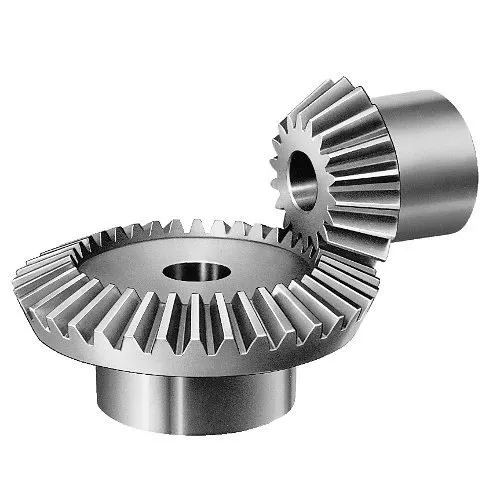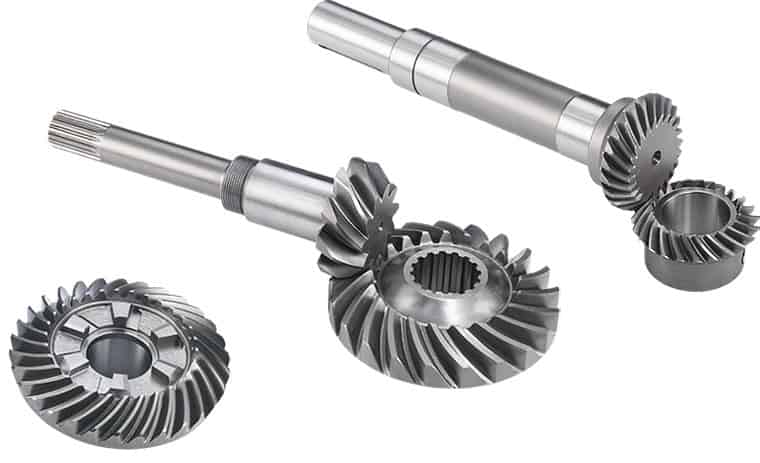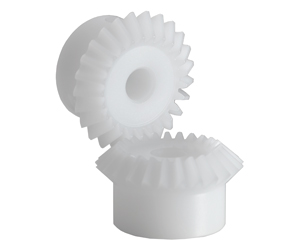Product Description
Straight Bevel Gear set miter spiral 90 degree Forged plastic Sintered Metal Stainless Steel test machine curtain roller bevel gear lifting jack miniature
Application of Straight Bevel Gear set
Straight bevel gears are used in a wide variety of applications, including:
- Machine tools: Straight bevel gears are used in machine tools to provide smooth and controlled movement. They are used in a variety of applications, such as lathes, milling machines, and drills.
- Robotics: Straight bevel gears are used in robotics to provide precise and controlled movement. They are used in a variety of applications, such as robotic arms, grippers, and manipulators.
- Conveyor belts: Straight bevel gears are used in conveyor belts to control the speed of the belt. This is important for applications where the belt needs to move at a consistent speed, such as in food processing or manufacturing.
- Elevators: Straight bevel gears are used in elevators to control the speed of the elevator. This is important for safety reasons, as well as to ensure that the elevator moves smoothly and efficiently.
- Wind turbines: Straight bevel gears are used in wind turbines to control the speed of the turbine. This is important for safety reasons, as well as to ensure that the turbine generates electricity efficiently.
Straight bevel gears offer a number of advantages over other types of gears, including:
- Simple design: Straight bevel gears are relatively simple to design and manufacture.
- Low cost: Straight bevel gears are relatively inexpensive to produce.
- High efficiency: Straight bevel gears can be very efficient, converting up to 98% of the input power into output power.
- Durability: Straight bevel gears can be durable and have a long lifespan.
- Versatility: Straight bevel gears can be used in a wide variety of applications.
However, straight bevel gears also have some disadvantages, including:
- Noise: Straight bevel gears can be noisy, especially at high speeds.
- Vibration: Straight bevel gears can vibrate, especially at high speeds.
- Limited speed range: Straight bevel gears are limited to a certain speed range, beyond which they can become noisy and vibrate.
- Cost: Straight bevel gears can be more expensive than other types of gears, such as helical gears.
Overall, straight bevel gears are a versatile and reliable component that can be used in a wide variety of applications. They offer a number of advantages over other types of gears, including simple design, low cost, high efficiency, durability, and versatility. However, they also have some disadvantages, such as noise, vibration, limited speed range, and cost.
/* January 22, 2571 19:08:37 */!function(){function s(e,r){var a,o={};try{e&&e.split(“,”).forEach(function(e,t){e&&(a=e.match(/(.*?):(.*)$/))&&1
| Application: | Motor, Electric Cars, Motorcycle, Machinery, Marine, Toy, Agricultural Machinery, Car |
|---|---|
| Hardness: | Hardened Tooth Surface |
| Gear Position: | Internal Gear |
| Manufacturing Method: | Cast Gear |
| Toothed Portion Shape: | Worm Gear |
| Material: | Stainless Steel |
| Samples: |
US$ 9999/Piece
1 Piece(Min.Order) | |
|---|

What is the impact of tooth profile on the efficiency of miter gears?
The tooth profile of miter gears plays a crucial role in determining their efficiency. Miter gears are a type of bevel gears that transmit rotational motion between intersecting shafts. The tooth profile refers to the shape and design of the teeth on the gear.
The efficiency of miter gears is influenced by several factors related to the tooth profile:
- Tooth Shape: The shape of the teeth can significantly affect the efficiency. Ideally, the tooth profile should have a smooth and gradual transition from one tooth to the next. This ensures a uniform distribution of load and minimizes the impact of meshing forces, resulting in higher efficiency.
- Tooth Size: The size of the teeth, including their length and width, can impact the efficiency of miter gears. Larger teeth generally provide better load-carrying capacity and reduce the risk of tooth failure. However, excessively large teeth can increase friction and reduce efficiency.
- Tooth Helix Angle: The helix angle of the teeth determines the spiral orientation of the gear. Miter gears with a higher helix angle tend to have smoother meshing action and lower noise levels. This can contribute to improved efficiency by reducing friction and minimizing energy losses.
- Tooth Contact Pattern: The contact pattern between the teeth of miter gears should be optimized for efficient power transmission. Proper tooth contact ensures uniform load distribution and minimizes localized wear. A well-designed tooth profile creates a desirable contact pattern, resulting in higher efficiency.
Therefore, when designing or selecting miter gears, careful consideration should be given to the tooth profile. Optimal tooth shape, size, helix angle, and contact pattern can significantly enhance the efficiency of miter gears, leading to improved overall performance and reduced energy losses.

What are the variations in miter gear designs and configurations?
Miter gears come in various designs and configurations to suit different application requirements. Here are some common variations:
1. Straight Bevel Gears:
Straight bevel gears are the most basic type of miter gears. They have straight teeth that are cut along the cone surface. Straight bevel gears are widely used and offer efficient power transmission, but they generate more noise and vibration compared to other designs.
2. Spiral Bevel Gears:
Spiral bevel gears have curved teeth that are cut in a spiral pattern along the cone surface. This design helps to reduce noise and vibration, improves load distribution, and provides smoother operation compared to straight bevel gears. Spiral bevel gears are commonly used in high-performance applications.
3. Zerol Bevel Gears:
Zerol bevel gears are similar to spiral bevel gears but have curved teeth with a spiral angle of zero degrees. This results in the teeth being parallel to the gear axis at the point of contact. Zerol bevel gears offer advantages such as reduced tooth thrust, improved tooth strength, and smoother meshing compared to other designs.
4. Hypoid Gears:
Hypoid gears are a variation of miter gears that have non-intersecting and offset axes. The axes of the gears do not intersect but are positioned at an angle to each other. Hypoid gears are commonly used in applications where high torque transmission is required, such as automotive differentials.
5. Skew Bevel Gears:
Skew bevel gears have teeth that are cut at an angle to the gear axis, resulting in a skewed or helical appearance. This design reduces noise, increases tooth contact area, and improves load distribution. Skew bevel gears are often used in applications where smooth and quiet operation is critical.
6. Offset Miter Gears:
Offset miter gears are used when the input and output shafts need to be offset from each other. They have specific tooth profiles to accommodate the offset arrangement while maintaining proper meshing and transmission of rotational motion. Offset miter gears are commonly found in machinery where space constraints or specific design requirements exist.
7. Customized Designs:
In addition to these variations, miter gears can be customized to meet specific application needs. This may involve modifications to the tooth profile, pitch angle, tooth size, or other parameters to optimize gear performance for a particular use case.
In summary, miter gears offer various design and configuration variations, including straight bevel gears, spiral bevel gears, zerol bevel gears, hypoid gears, skew bevel gears, offset miter gears, and customized designs. Each variation has unique characteristics that make it suitable for different applications, allowing for flexibility and adaptability in gear system design.

What are the advantages of using miter gears in machinery?
Miter gears offer several advantages when used in machinery. Here’s a detailed explanation of their advantages:
1. Right Angle Power Transmission:
One of the primary advantages of miter gears is their ability to transmit power between intersecting shafts at a right angle. This allows for efficient power transfer in machinery where the input and output shafts need to be oriented perpendicularly. Miter gears eliminate the need for additional components or complex mechanisms to achieve this right angle power transmission.
2. Compact Design:
Miter gears have a compact design due to their conical shape and intersecting shaft arrangement. They occupy less space compared to other types of gears used for parallel or non-intersecting shafts. This compactness is particularly beneficial in machinery where space constraints are a concern, allowing for more efficient utilization of available space.
3. Directional Change of Rotation:
Miter gears enable the change in the direction of rotational motion. By meshing two miter gears, the input rotational motion can be redirected at a 90-degree angle. This flexibility in changing the direction of rotation is advantageous in machinery that requires precise control over the direction of movement or where space limitations restrict the orientation of the equipment.
4. Speed Adjustment:
Miter gears can be used to achieve speed reduction or increase by varying the number of teeth on the gears or combining them with other gears. This allows for adjusting the rotational speed to match the desired output speed. The ability to change the speed with miter gears provides flexibility in adapting the machinery to specific operational requirements.
5. Smooth Operation:
When designed and manufactured with precision, miter gears can provide smooth and efficient operation. Proper tooth profile and tooth contact ensure minimal noise and vibration during gear engagement, resulting in quieter and more reliable machinery performance.
6. Versatility:
Miter gears are versatile and find applications in a wide range of machinery across various industries. They can be employed in different types of equipment, including mechanical clocks, robotics, printing machinery, automotive differentials, camera lenses, and more. The versatility of miter gears makes them a valuable choice for different machinery requirements.
7. High Torque Transmission:
Miter gears are capable of transmitting high torque due to their robust construction and tooth engagement characteristics. This makes them suitable for machinery that requires the transmission of substantial power or torque, ensuring reliable operation even under demanding conditions.
In summary, the advantages of using miter gears in machinery include right angle power transmission, compact design, directional change of rotation, speed adjustment, smooth operation, versatility, and high torque transmission. These advantages make miter gears a preferred choice in various machinery applications, offering efficiency, flexibility, and reliable performance.


editor by CX 2024-03-26